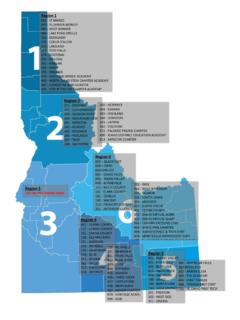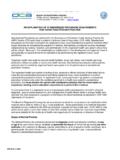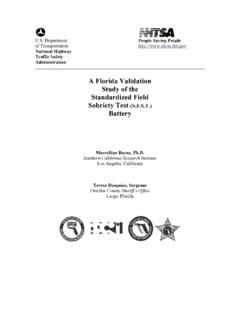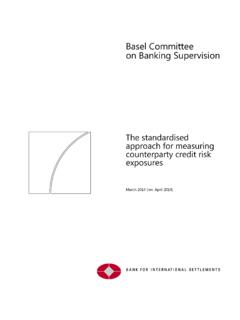Transcription of Summary Information: Bayley –III Scales of Infant and ...
1 DRAFT Bayley III Crosswalk 6-8-06 1 Summary Information: Bayley III Scales of Infant and Toddler Development, 3rd Edition Name Bayley III Scales of Infant and Toddler Development, 3rd Edition Publisher PsychCorp Website for information Cost $ Bayley -III Screening Test Kit Includes: Screener Manual (Technical +Administration), Screener Stimulus Book, 25 Screener Record Forms, Picture Book, Screener Manipulative Set Age range: 1-42 months Purpose identify the child s developmental competencies; identify deficits in very young children across five major developmental domains Areas included Cognitive Language Motor Social-emotional Adaptive behavior Time to administer 50-90 minute for entire battery Scored Total raw score for each subtest Type of Scores Scaled scores Composite scores Percentile ranks Growth scores Age norms Yes Age ranges given for items Yes How frequently it can be given Periodically during course of intervention standardized tasks yes DRAFT Bayley III Crosswalk 6-8-06 2 Based on observation in natural settings No Instructions related to parent role Yes.
2 Parent role with very young children to encourage child responsiveness to examiner; parent questionnaires related to social-emotional, adaptive behavior. Data provided on reliability Yes. Internal consistency ; Standard error of measurement, Test-retest stability, Inter-Rater Reliability Data provided on validity Yes. Content and Construct Validity; Correlated with subtests and measures of similar content: BSID-II, Weschler Preschool and Primary Scale of Intelligence (3rd ed.), Preschool Lange Scale (4th Ed.), Peabody Developmental; Motor Scales (2nd Ed.) Adaptive Behavior Assessment System (2nd Ed.) ; mean comparisons with matched special groups and typically developing children Web-based data entry No Electronic scoring Yes.
3 Score and compile individual assessment results via PC or PDA . Other languages English only Who administers Trained examiner/staff. Training available through the publisher Yes. DRAFT Bayley III Crosswalk 6-8-06 3 Bayley Scales of Infant and Toddler Development Third Edition: Crosswalk to Child Outcomes Note: Because the Bayley is a norm-referenced, standardized assessment, the subscale scores are the smallest unit of information that can be used to reach conclusions about the extent to which a child is demonstrating each of the functional outcomes. This table shows how the subscales map to the three outcomes. Under each subscale, the X indicates the outcome area to which the subscale score contributes information.
4 The item information under the X provides the rationale for why the subscale was classified as providing information for that outcome. Outcome 1 Positive social relationships Outcome 2 Acquire and use skills and knowledge Outcome 3 Takes action to meet needs Subscale: COGNITIVE (Cog) X Cognitive (Cog) Cog 1-39 (Precursor Skills: attention and anticipatory behavior; exploration of environment; self awareness; object retention; cause and effect; object permanence) Cog 40 55 (Simple problem solving; relational play; following instructions) Cog 56-69 (problem solving; attends to story; object assembly, matching; representational play; imitation; imaginary play) Cog 70- 91 (numeracy; multischeme combination play; grouping; sorting; classification; spatial memory.)
5 Discrimination) DRAFT Bayley III Crosswalk 6-8-06 4 Subscale: LANGUAGE (Lang) X X X Language: Receptive Communication (RC) RC 9-14(Responds to name; responds to words; attends others; responds to request) RC 1-8 Precursor Skills: turns head to sound; regards person momentarily; responds to voice, discriminates sound, interacts with objects) RC 9-14(Responds to name; responds to words; attends others; responds to request) RC 15-29 (Identification; following directions) RC 30-49 (Grammar; labels for mass and size; understanding more, most, less, and least; understanding negatives; tense; descriptive labels; categorizing objects) Language: Expressive Communication EC 2-7 (Precursor skills: smiling; vocalizing mood; social vocalization; gaining attention) EC 17 (Initiates play interaction) EC 1-13 (Precursor skills: making sounds; smiling; vocalizing mood; social vocalization; vowel sounds, consonant sounds; gaining attention; using gestures; expressive jabbering) EC 14- 29 (One word approximations; imitation; Directing others attention; appropriate use of words; EC 3-12 (Precursor skills: social vocalization; gaining attention, using gestures.
6 Expressive jabbering) EC 19 (uses words to make wants known) DRAFT Bayley III Crosswalk 6-8-06 5 naming object or picture, responding to questions) EC 30-48 (Grammar; questioning, tense; Describing pictures; object usage; answering questions) Subscale: MOTOR X* Motor: Fine Motor (FM) FM 1-66 (Movement precursors to taking action)* Motor: Gross Motor (GM) GM1-72 (Movement precursors to taking action)* Subscale: SOCIAL-EMOTIONAL (SE) X X X Social Emotional (SE) SE 1-11 (getting attention; responsiveness) SE 12-13 (Happy response when sees person; responds by making sounds or faces, interaction through expressions or actions) SE 15-16, 21 (Exchanges looks, sounds, or actions; responds with appropriate gesture, uses words) SE 35 ( Has conversations) SE 18 (Imitation,) SE 22, 24-27, 29, 34 (Imitates play, uses words, plays make-believe) SE 14 (Gestures to show what he/she wants) SE 17, 19, 20, 23, (Actions to show what he/she wants; searches for what he/she wants with or without help; says what he/she wants) SE 28, 31-33 (describes feelings and wants; explains wants.
7 Asks for what he/she wants) DRAFT Bayley III Crosswalk 6-8-06 6 Subscale: ADAPTIVE BEHAVIOR X X X Adaptive Behavior: Communication (Com)** Com 1-2, 4, 9(Attends to others; cries; laughs) Com 23-24 (Ends conversation appropriately, refrains from interrupting) Com 6-18 (Names people and objects ; points to objects; responds to question; follows directions Com14-22 (Sings song, grammar, sentence usage, names objects, asks questions) Com 3, 5 (Expresses feelings and needs vocally; raises voice for attention Adaptive Behavior: Community Use (CU) CU 2, 16,18-20 ( Walks on sidewalk; looks both ways before crossing street, Finds restroom in public places, orders meals, makes purchases) Adaptive Behavior: Functional Pre-Academics (FA) FA 1-23 (Colors; counting; knowing, reading, and spelling name; age; writing; days of the week, knows nursery rhymes FA 18 (Reading and obeying signs) Adaptive Behavior: Home Living (HL) HL 1-2, 5-9, 11-12, 14-18, 20-25 (Performs household chores and tasks , feeds self, cleans up after self, makes bed, folds clothes) Adaptive Behavior: Health and Safety (HS)** HS 1-24 (Follows directions to avoid danger; expresses when hurt; takes action to avoid injury.)))
8 Cares for own minor DRAFT Bayley III Crosswalk 6-8-06 7 injuries) Adaptive Behavior: Leisure (LS)** LS 1-22 (Playing alone, with adults, or in groups; following game rules) Adaptive Behavior: Self Care (SC)** SC (Feeds self; drinks from cup; assists caretaker with self care activities; asks for food, washes hands, toileting, brushes teeth, dresses self, bathes self) Adaptive Behavior: Self Direction (SD)** SD 10, 12-14, 18,20-21,22,23 (Follows adult request and rules, controls temper, asks permission, discusses ways to solve conflicts) SD 11, 24 (Tries to do things without adult help; chooses own clothes) Adaptive Behavior: Social (Soc)** Soc 1-24 (Smiles; sense of humor; responds differently to familiar and unfamiliar persons; shares toys; says thank you; shows sympathy; seeks friendship; expresses feelings; refrains from saying hurtful things.
9 Adaptive Behavior: Motor (MO)** MO 1-27 (Movement precursors to taking action)* *Precursor skills for functional behaviors. These skills may not be appropriate or expected for some children with motor impairments ** For children younger than one year, the GAC is calculated using only those skill areas indicated by an asterisk.











